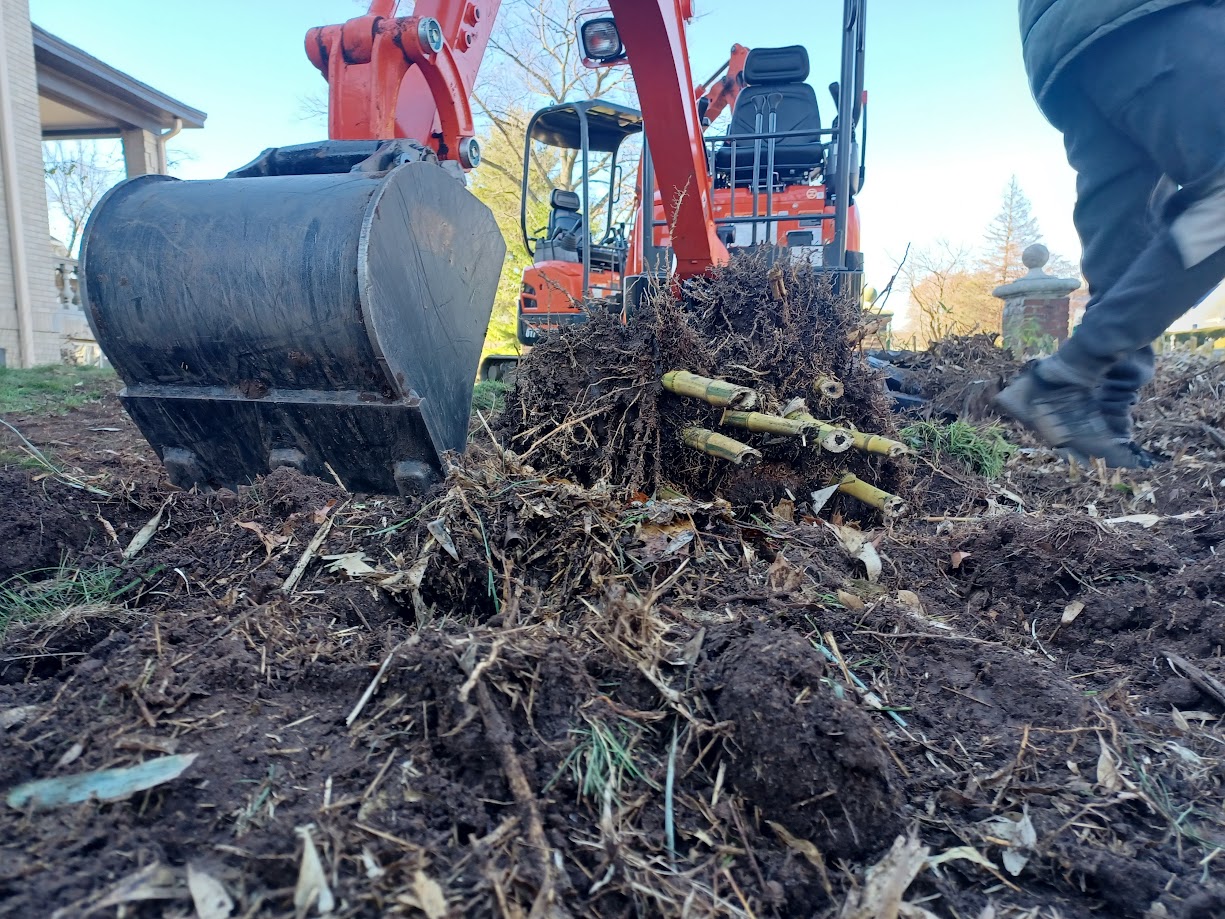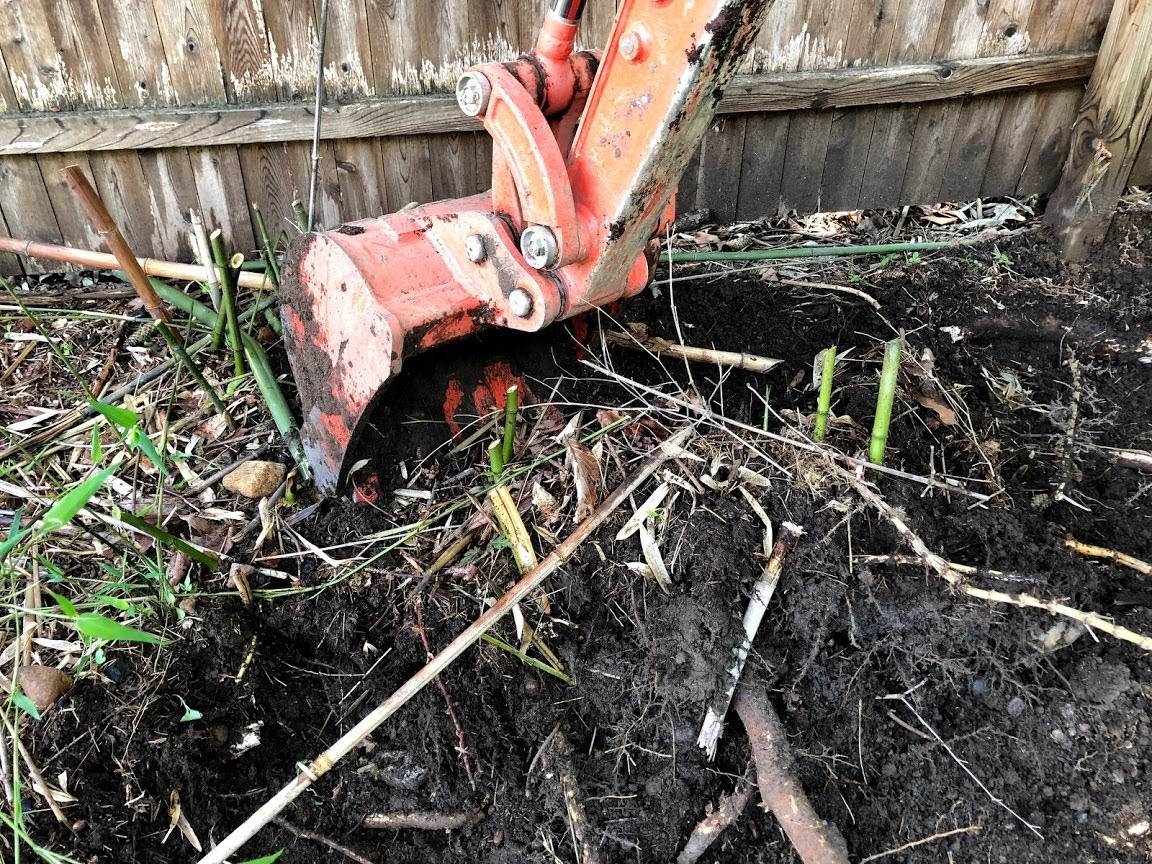More about bamboo
Bamboo is a fast-growing grass that has been cultivated for thousands of years all over the world. It is famous for its versatility, sustainability, and beauty, which have made it a popular choice in landscaping and construction projects. However, it is essential to note that not all bamboo species are created equal. Some bamboo species are invasive and can pose a significant threat to the environment, human health, and property.
 Invasive bamboo refers to species of bamboo that have aggressive growth characteristics, making them difficult to control and eradicate once established in a particular area. The invasive nature of bamboo can be attributed to its unique reproductive properties, hardy root system, and tolerance to different soil, water, and climatic conditions. This essay explores the different ways in which invasive bamboo can be problematic, its impact on the environment and human health, and methods of control and management.Characteristics of Invasive Bamboo:One of the key characteristics of invasive bamboo is its rapid growth rate. Most invasive bamboo species can grow more than three feet per day, meaning that they can cover significant distances in a short period, crowding out other plant species, and creating dense stands. Unlike other plants, most bamboo species do not produce seeds for reproduction. Instead, they spread through underground rhizomes, creating new shoots several feet away from the parent plant. This means that controlling and eradicating bamboo becomes challenging as it forms dense stands and spreads underground.Invasive bamboo also has a hardy root system that can forge through concrete, paving, and other solid surfaces. This creates significant problems for property owners as the bamboo roots can damage foundations, walls, and other structures, compromising their stability and integrity. Furthermore, the underground root system can interfere with drainage and irrigation systems, causing flooding and erosion.Impact of Invasive Bamboo on the Environment:The presence of invasive bamboo can have significant negative effects on the environment, especially on biodiversity. Invasive bamboo species can create dense stands that outcompete native plant species, reducing both the species and habitat diversity. The lack of biodiversity can negatively impact ecosystems by affecting energy flow, nutrient cycling, and nutrient uptake. Lower diversity can also create a loss of structural and functional unique features, which can alter ecosystem processes and services.Bamboo invasion can restrict wildlife movement and pruning activities, limiting food and shelter opportunities for animals. Dense bamboo stands can pose barriers to animal movement and alter their natural migration patterns. Furthermore, the bamboo canopy will limit sunlight penetration, affecting soil quality and nutrient uptake, making it difficult for both native plant and animal species to thrive.Invasive bamboo can also affect water quality and quantity. The extensive root systems of bamboo can alter local water tables and alter stream channels, leading to sedimentation and erosion. Bamboo can also exacerbate the effects of storms and floods, catching and holding accumulated debris, leading to severe damage and flooding during high rainfall events.Impact of Invasive Bamboo on Human Health:Invasive bamboo can also pose a threat to human health, especially through allergic reactions. Bamboo produces pollen, which can cause allergies in some people, leading to overall discomfort and reduced quality of life in some communities. The pollen can also lead to respiratory illness and aggravate the symptoms of people with asthma and allergies. The bamboo leaves can also cause skin irritations and contact dermatitis after exposure to human skin.Invasive bamboo can also create a threat to structural integrity and safety of buildings and other infrastructure. The root system of bamboo can be potent enough to cause structural damage to buildings, especially if it interferes with the foundation. As the bamboo grows, it can compromise the stability of retaining walls and structures, leading to the potential risk of collapse.Control and Management of Invasive Bamboo:The control and management of invasive bamboo depend on species, scale, and objective control. The primary goal of controlling invasive bamboo is to limit its spread and create economic benefits from it while minimizing its detrimental impact on the environment and human health.One of the most effective management strategies is to prevent invasive bamboo from starting. It is essential to understand the different growth characteristics, and the potential for invasion before planting a chosen species. Selective planting of bamboo species, such as clumping bamboo, which has a non-invasive root system, is an excellent way of controlling the spread’s bamboo.Another method that can be used is containment and physical control. This can include the use of barriers, such as underground injection, physical barriers, or trenching. These methods aim to contain invasive bamboo’s underground root system and provide optimal control over its spread. It is essential to note that containment measures, and physical controls should be adequately planned and implemented as improper control can lead to the spread of the invasive bamboo.
Invasive bamboo refers to species of bamboo that have aggressive growth characteristics, making them difficult to control and eradicate once established in a particular area. The invasive nature of bamboo can be attributed to its unique reproductive properties, hardy root system, and tolerance to different soil, water, and climatic conditions. This essay explores the different ways in which invasive bamboo can be problematic, its impact on the environment and human health, and methods of control and management.Characteristics of Invasive Bamboo:One of the key characteristics of invasive bamboo is its rapid growth rate. Most invasive bamboo species can grow more than three feet per day, meaning that they can cover significant distances in a short period, crowding out other plant species, and creating dense stands. Unlike other plants, most bamboo species do not produce seeds for reproduction. Instead, they spread through underground rhizomes, creating new shoots several feet away from the parent plant. This means that controlling and eradicating bamboo becomes challenging as it forms dense stands and spreads underground.Invasive bamboo also has a hardy root system that can forge through concrete, paving, and other solid surfaces. This creates significant problems for property owners as the bamboo roots can damage foundations, walls, and other structures, compromising their stability and integrity. Furthermore, the underground root system can interfere with drainage and irrigation systems, causing flooding and erosion.Impact of Invasive Bamboo on the Environment:The presence of invasive bamboo can have significant negative effects on the environment, especially on biodiversity. Invasive bamboo species can create dense stands that outcompete native plant species, reducing both the species and habitat diversity. The lack of biodiversity can negatively impact ecosystems by affecting energy flow, nutrient cycling, and nutrient uptake. Lower diversity can also create a loss of structural and functional unique features, which can alter ecosystem processes and services.Bamboo invasion can restrict wildlife movement and pruning activities, limiting food and shelter opportunities for animals. Dense bamboo stands can pose barriers to animal movement and alter their natural migration patterns. Furthermore, the bamboo canopy will limit sunlight penetration, affecting soil quality and nutrient uptake, making it difficult for both native plant and animal species to thrive.Invasive bamboo can also affect water quality and quantity. The extensive root systems of bamboo can alter local water tables and alter stream channels, leading to sedimentation and erosion. Bamboo can also exacerbate the effects of storms and floods, catching and holding accumulated debris, leading to severe damage and flooding during high rainfall events.Impact of Invasive Bamboo on Human Health:Invasive bamboo can also pose a threat to human health, especially through allergic reactions. Bamboo produces pollen, which can cause allergies in some people, leading to overall discomfort and reduced quality of life in some communities. The pollen can also lead to respiratory illness and aggravate the symptoms of people with asthma and allergies. The bamboo leaves can also cause skin irritations and contact dermatitis after exposure to human skin.Invasive bamboo can also create a threat to structural integrity and safety of buildings and other infrastructure. The root system of bamboo can be potent enough to cause structural damage to buildings, especially if it interferes with the foundation. As the bamboo grows, it can compromise the stability of retaining walls and structures, leading to the potential risk of collapse.Control and Management of Invasive Bamboo:The control and management of invasive bamboo depend on species, scale, and objective control. The primary goal of controlling invasive bamboo is to limit its spread and create economic benefits from it while minimizing its detrimental impact on the environment and human health.One of the most effective management strategies is to prevent invasive bamboo from starting. It is essential to understand the different growth characteristics, and the potential for invasion before planting a chosen species. Selective planting of bamboo species, such as clumping bamboo, which has a non-invasive root system, is an excellent way of controlling the spread’s bamboo.Another method that can be used is containment and physical control. This can include the use of barriers, such as underground injection, physical barriers, or trenching. These methods aim to contain invasive bamboo’s underground root system and provide optimal control over its spread. It is essential to note that containment measures, and physical controls should be adequately planned and implemented as improper control can lead to the spread of the invasive bamboo.

Chemical control is another common control method used to eradicate or manage invasive bamboo. The herbicides contain glyphosate, imazapyr, triclopyr, among others, which are sprayed on the bamboo leaves and can work systemically to kill the roots and the plant itself. It is important to emphasize that chemical control should be used like a last resort and maybe the best approach for small-scale infestations due to its potential negative impact on non-target species.Conclusion:The invasive nature of bamboo has made it one of the most challenging plant species to control and manage. Invasive bamboo’s growth characteristics and the hardy root system make it difficult to manage once established. The impact of invasive bamboo can affect biodiversity, water quality, human health, and property values. As such, it is essential to implement effective control measures and management strategies to minimize the negative impacts of invasive bamboo. Control measures such as prevention, containment and physical control and chemical control are available but should be implemented adeptly to ensure effectiveness while minimizing negative impacts on the environment and human health.
